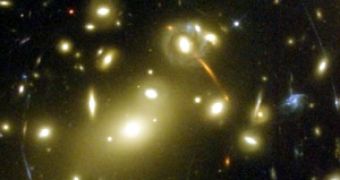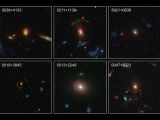"Leave your telescopes at home, we won't need them for the next observation," would probably say Einstein. Indeed, the universe is dominated on the large scale by this mysterious force we call gravity, but it is not only responsible for keeping the universe from falling apart. Gravitational lensing, for example, is another of the many effects determined by gravity. It was predicted by famous German physicist Albert Einstein as a direct solution of the Theory of Relativity, which postulates that while passing through the vicinity of a massive body, the trajectory of a beam of light would be slightly bent by gravity.
Thus came the total solar eclipse in 1905, when Albert Einstein confirmed the first of a long list of predictions made with the help of the Theory of Relativity, as he observed light being bent in the vicinity of the Sun. And as the Theory of Relativity postulates that the laws of the universe are the same in its every point, the first-ever gravitational lens was discovered in 1979. Since then, about 67 gravitational lensing effects in relation to the Earth have been discovered throughout the visible universe.
Gravitational lenses work much in the same way as transparent optical lenses, refracting light and magnifying it multiple times, depending on the strength of the gravitational field that generates it, of course. Extremely distant galaxies, invisible without the assistance of gravitational lenses, can be observed and studied this way. Based on the number of gravitational lensing effects discovered so far, astronomers estimate that there are about half of million gravitational lenses in relation to Earth scattered throughout the visible universe.
They usually occur in the vicinity of extremely massive objects or a collection of objects - such as a galaxy cluster, or star cluster - through the warping of the space-time fabric around them. Light no longer travels in a straight line while passing through the warped volume of space, causing it to bend. If the distance between the source of light, the gravitational lens and the observer are just right, then the background image will appear distorted and magnified.
In perfect gravitational lensing conditions, one would be able to observe a magnification factor ranging between 10 to 50. Finding such gravitational lensing effects, on the other hand, is not as intriguing as someone might think, as images taken with the Hubble Space Telescope are studied individually by eye, in the hope to discover the circular warping of light characteristic to gravitational lenses.
Astronomers argue that by understanding how many gravitational lensing effects are visible from Earth, they can actually evaluate the amount of matter spread throughout the galaxies which cause the appearance of these lenses. We already know that more than 75 percent of the mass of the universe is represented by invisible dark matter, but this information is to no use unless one knows the distribution of this matter inside galaxies.
Additionally, space-time warping characteristics can provide an insight in the structure of galaxies creating the lens by studying the shape of the distortion.

 14 DAY TRIAL //
14 DAY TRIAL // 
